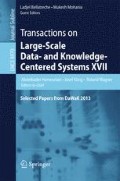Abstract
Dimensionality reduction is a crucial ingredient of machine learning and data mining, boosting classification accuracy through the isolation of patterns via omission of noise. Nevertheless, recent studies have shown that dimensionality reduction can benefit from label information, via a joint estimation of predictors and target variables from a lowf-rank representation. In the light of such inspiration, we propose a novel dimensionality reduction which simultaneously reconstructs the predictors using matrix factorization and estimates the target variable via a dual-form maximum margin classifier from the latent space. Compared to existing studies which conduct the decomposition via linearly supervision of targets, our method reconstructs the labels using nonlinear functions. If the hyper-plane separating the class regions in the original data space is non-linear, then a nonlinear dimensionality reduction helps improving the generalization over the test instances. The joint optimization function is learned through a coordinate descent algorithm via stochastic updates. Empirical results demonstrate the superiority of the proposed method compared to both classification in the original space (no reduction), classification after unsupervised reduction, and classification using linearly supervised projection.
Access this chapter
Tax calculation will be finalised at checkout
Purchases are for personal use only
References
Samet, H.: Foundations of Multidimensional and Metric Data Structures (The Morgan Kaufmann Series in Computer Graphics and Geometric Modeling). Morgan Kaufmann Publishers Inc., San Francisco (2005)
Grabocka, J., Bedalli, E., Schmidt-Thieme, L.: Efficient classification of long time-series. In: Markovski, S., Gushev, M. (eds.) ICT Innovations 2012. AISC, vol. 207, pp. 47–57. Springer, Heidelberg (2013)
Grabocka, J., Nanopoulos, A., Schmidt-Thieme, L.: Classification of sparse time series via supervised matrix factorization. In: Hoffmann, J., Selman, B. (eds.) AAAI, AAAI Press (2012)
Das Gupta, M., Xiao, J.: Non-negative matrix factorization as a feature selection tool for maximum margin classifiers. In: Proceedings of the 2011 IEEE Conference on Computer Vision and Pattern Recognition, CVPR 2011, pp. 2841–2848. IEEE Computer Society, Washington, DC (2011)
Jolliffe, I.T.: Principal Component Analysis, 2nd edn. Springer, New York (2002)
Wismüller, A., Verleysen, M., Aupetit, M., Lee, J.A.: Recent advances in nonlinear dimensionality reduction, manifold and topological learning. In: ESANN (2010)
Hoffmann, H.: Kernel pca for novelty detection. Pattern Recognit. 40(3), 863–874 (2007)
Sun, J., Crowe, M., Fyfe, C.: Extending metric multidimensional scaling with bregman divergences. Pattern Recognit. 44(5), 1137–1154 (2011)
Gorban, A.N., Zinovyev, A.Y.: Principal manifolds and graphs in practice: from molecular biology to dynamical systems. Int. J. Neural Syst. 20(3), 219–232 (2010)
Lee, J.A., Verleysen, M.: Nonlinear Dimensionality Reduction. Springer, New York; London (2007)
Gashler, M.S., Martinez, T.: Temporal nonlinear dimensionality reduction. In: Proceedings of the IEEE International Joint Conference on Neural Networks, IJCNN 2011, pp. 1959–1966. IEEE Press (2011)
Lawrence, N., Hyvrinen, A.: Probabilistic non-linear principal component analysis with gaussian process latent variable models. J. Mach. Learn. Res. 6, 1783–1816 (2005)
Lawrence, N.: Gaussian process latent variable models for visualisation of high dimensional data. In: NIPS (2003, 2004)
Singh, A.P., Gordon, G.J.: A unified view of matrix factorization models. In: Daelemans, W., Goethals, B., Morik, K. (eds.) ECML PKDD 2008, Part II. LNCS (LNAI), vol. 5212, pp. 358–373. Springer, Heidelberg (2008)
Koren, Y., Bell, R.M., Volinsky, C.: Matrix factorization techniques for recommender systems. IEEE Comput. 42(8), 30–37 (2009)
Rendle, S., Schmidt-Thieme, L.: Online-updating regularized kernel matrix factorization models for large-scale recommender systems. In: Pu, P., Bridge, D.G., Mobasher, B., Ricci, F. (eds.) RecSys, pp. 251–258. ACM (2008)
Cai, D., He, X., Han, J., Huang, T.S.: Graph regularized nonnegative matrix factorization for data representation. IEEE Trans. Pattern Anal. Mach. Intell. 33(8), 1548–1560 (2011)
Giannakopoulos, T., Petridis, S.: Fisher linear semi-discriminant analysis for speaker diarization. IEEE Trans. Audio Speech Lang. Process. 20(7), 1913–1922 (2012)
Menon, A.K., Elkan, C.: Predicting labels for dyadic data. Data Min. Knowl. Discov. 21(2), 327–343 (2010)
Rish, I., Grabarnik, G., Cecchi, G., Pereira, F., Gordon, G.J.: Closed-form supervised dimensionality reduction with generalized linear models. In: ICML 2008: Proceedings of the 25th International Conference on Machine Learning, pp. 832–839. ACM, New York (2008)
Rennie, J.D.M.: Loss functions for preference levels: regression with discrete ordered labels. In: Proceedings of the IJCAI Multidisciplinary Workshop on Advances in Preference Handling, pp. 180–186 (2005)
Fukumizu, K., Bach, F.R., Jordan, M.I.: Dimensionality reduction for supervised learning with reproducing kernel hilbert spaces. J. Mach. Learn. Res. 5, 73–99 (2004)
Salakhutdinov, R., Hinton, G.: Learning a nonlinear embedding by preserving class neighbourhood structure. In: Proceedings of the International Conference on Artificial Intelligence and Statistics, vol. 11 (2007)
Zhang, D., Zhou, Z.-H., Chen, S.: Semi-supervised dimensionality reduction. In: Proceedings of the 7th SIAM International Conference on Data Mining, pp. 11–393 (2007)
Urtasun, R., Darrell, T.: Discriminative gaussian process latent variable models for classification. In: International Conference in Machine Learning (2007)
Scholkopf, B., Smola, A.J.: Learning with Kernels: Support Vector Machines, Regularization, Optimization, and Beyond. MIT Press, Cambridge (2001)
Platt, J.: Fast training of support vector machines using sequential minimal optimization. In: Schoelkopf, B., Burges, C., Smola, A. (eds.) Advances in Kernel Methods - Support Vector Learning. MIT Press, Cambridge (1998)
Acknowledgment
This study was funded by the Seventh Framework Programme (FP7) of the European Commission, through projects REDUCTION(www.reduction-project.eu) and iTalk2Learn(www.italk2learn.eu).
In addition, the authors express their gratitude to Lucas Rego Drumond (University of Hildesheim) for his assistance on formalizing the linearly supervised decomposition.
Author information
Authors and Affiliations
Corresponding author
Editor information
Editors and Affiliations
Rights and permissions
Copyright information
© 2015 Springer-Verlag Berlin Heidelberg
About this chapter
Cite this chapter
Grabocka, J., Schmidt-Thieme, L. (2015). Learning Through Non-linearly Supervised Dimensionality Reduction. In: Hameurlain, A., Küng, J., Wagner, R., Bellatreche, L., Mohania, M. (eds) Transactions on Large-Scale Data- and Knowledge-Centered Systems XVII. Lecture Notes in Computer Science(), vol 8970. Springer, Berlin, Heidelberg. https://doi.org/10.1007/978-3-662-46335-2_4
Download citation
DOI: https://doi.org/10.1007/978-3-662-46335-2_4
Published:
Publisher Name: Springer, Berlin, Heidelberg
Print ISBN: 978-3-662-46334-5
Online ISBN: 978-3-662-46335-2
eBook Packages: Computer ScienceComputer Science (R0)

